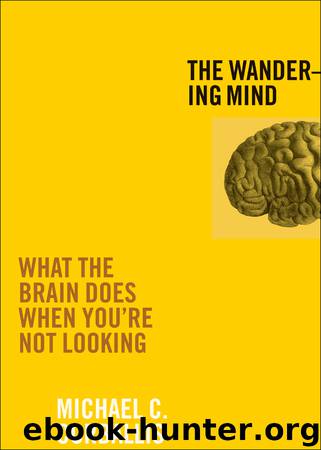The Wandering Mind by Michael C Corballis

Author:Michael C Corballis [C. Corballis, Michael]
Format: epub
Tags: Psychology
Publisher: Auckland University Press (Perseus)
Published: 2014-06-02T16:00:00+00:00
And so language itself was born
In the early stages, perhaps, stories were told as pantomimes, as people acted out their experiences. But pantomime is inefficient and often ambiguous, and needed to be developed into a system of symbols whose meanings were clear, and understood by members of the community. Once, in a hotel in Moscow, I tried to ask at the front desk for a corkscrew, and having no knowledge of Russian pantomimed the act of opening a bottle, pouring imaginary liquid into an imaginary glass, lifting it to my lip, and making glugging noises. This caused consternation behind the desk, until they understood what I wanted. Consternation turned to hilarity and they found me the desired object. It would have been much more efficient if I had been able simply to ask for a corkscrew.
In the early Pleistocene, then, the complex activities undertaken by our forebears, such as hunting down and killing an animal, may have initially been acted out bodily, but then ‘conventionalised’ to make the meaning clear. Instead of representing the action in a holistic, visual fashion, separate actions might be developed to refer to the animal, a spear, and act of throwing, the location, and perhaps the time (yesterday, this morning). Each act could be reduced to a standard form, and need no longer retain the pictorial element of pantomime. Communities could come to agree on the meanings of individual acts, and pass them on to the children. This process can be seen in gestural form in the development of sign languages invented by deaf communities.
Once gestures were conventionalised, the element of pantomime disappeared, and vocal gestures largely replaced manual ones. Even so, most of us, and especially Italians, gesture with our hands as we speak, and this often provides pictorial or spatial cues to elaborate what we’re trying to say. Sometimes we resort to pure pantomime. Try asking people to tell you what a spiral is. Words generally fail them, and they resort to pantomime. Sign languages do retain an element of pantomime, but skilled signers do not notice the pantomimic element. Gestures have become symbols, not moving pictures. Whether gestured or spoken, these conventionalised symbols are called words.
Rules could then be established to convey sequences and relations between story elements. These rules might dictate the order in which the words should occur. They too can be arbitrary, but once established are necessary to make narrative meaning clear. So it is that grammar was born. Many simple events involve what linguists call an actor, an action and a patient; for instance, the event might have been that a woman (actor) picked (action) an apple (patient). These constituents are represented in word form as subject, verb and object, and the order in which they are produced is entirely a matter of convention. English is an SVO language, but the majority of languages, like Latin, are SOV, placing the verb last. All six possible orders are to be found among the world’s 7000 or so languages. The
Download
This site does not store any files on its server. We only index and link to content provided by other sites. Please contact the content providers to delete copyright contents if any and email us, we'll remove relevant links or contents immediately.
The Art of Thinking Clearly by Rolf Dobelli(10217)
The 5 Love Languages: The Secret to Love That Lasts by Gary Chapman(9588)
Mindhunter: Inside the FBI's Elite Serial Crime Unit by John E. Douglas & Mark Olshaker(9199)
Becoming Supernatural by Dr. Joe Dispenza(8119)
Nudge - Improving Decisions about Health, Wealth, and Happiness by Thaler Sunstein(7615)
The Road Less Traveled by M. Scott Peck(7522)
Enlightenment Now: The Case for Reason, Science, Humanism, and Progress by Steven Pinker(7228)
Mastermind: How to Think Like Sherlock Holmes by Maria Konnikova(7227)
Win Bigly by Scott Adams(7094)
The Way of Zen by Alan W. Watts(6505)
Factfulness: Ten Reasons We're Wrong About the World – and Why Things Are Better Than You Think by Hans Rosling(4694)
The State of Affairs by Esther Perel(4638)
Gerald's Game by Stephen King(4581)
Man's Search for Meaning by Viktor Frankl(4423)
The Confidence Code by Katty Kay(4187)
Thinking in Bets by Annie Duke(4152)
The Healing Self by Deepak Chopra(3473)
Hidden Persuasion: 33 psychological influence techniques in advertising by Marc Andrews & Matthijs van Leeuwen & Rick van Baaren(3472)
The Worm at the Core by Sheldon Solomon(3433)
